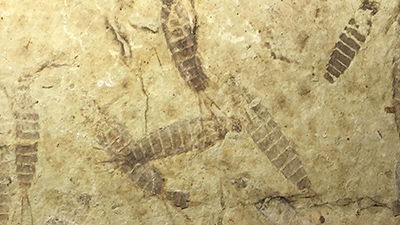Embryos or Spores?
Barking up the wrong multicellular tree
News Source
Precambrian fossils thought by evolutionists to be the earliest animal embryos have for a decade been considered the earliest evolved multicellular organisms. Fresh examination now seems “set to revoke the status of these most celebrated” fossils.
The original discovery of Precambrian fossilized embryos, according to Cambridge evolutionary paleobiologist Nicholas Butterfield, “was met with almost palpable relief.” Evolutionists believing in “gradualistic evolution” expected Precambrian oceans “must have swarmed with living animals” but couldn’t find their fossils. Noting this “conspicuous absence [of transitional fossils] from the early fossil record,” Butterfield comments, “The fossil record . . . had let us down.” These Precambrian embryos seemed to fill the gap. Now, examination of these microfossils using synchrotron-based X-ray imaging technology reveals they aren’t embryos or even animals. They are just spores.
These fossilized cellular clusters were found in 1998 in phosphate deposits in China’s Ediacaran Doushantuo Formation. Conventional dating assigns ages of 635 million to 551 million years to this region, and the alleged embryos come from the layers supposedly 570 million years old. The phosphates in the deposit are thought responsible for mineralizing the tiny organisms. The only fossils in such Precambrian layers are microfossils, and the absence of any matching “adult” fossil forms always cast a bit of doubt on the embryonic interpretation. Just above this geological layer are Cambrian layers with myriads of multicellular marine invertebrate fossils.
Co-author Dr. John Cunningham described the technology used to examine the microfossils. “We used a particle accelerator called a synchrotron as our X-ray source. It allowed us to make a perfect computer model of the fossil that we could cut up in any way that we wanted, but without damaging the fossil in any way. We would never have been able to study the fossils otherwise!”1
The fossils are so amazing that even their nuclei have been preserved.
Lead author Therese Huldtgren added, “The fossils are so amazing that even their nuclei have been preserved.”2
The detailed images revealed the cells were not differentiated like cells in embryos. Also, the nuclear contours in many of the cells were intact, a finding not consistent with rapidly dividing embryonic cells. Other characteristics showed these microfossils were not multicellular animals. The microfossils, as it turns out, are pretty much like the reproductive spore-forming phase of modern amoeboid protozoans.
Another team member, Professor Philip Donoghue, said, “We’ve been convinced for so long that these fossils represented the embryos of the earliest animals--much of what has been written about the fossils for the last ten years is flat wrong.”3
Professor Stefan Bengtson added, “These fossils force us to rethink our ideas of how animals learned to make large bodies out of cells.”4
Undaunted, Donoghue believes “the sophisticated behavior seen in these fossils” could have led the way to the Cambrian explosion by leading to “permanently multicellular arrangements.”
Single-celled organisms forming spore clusters like these live today and do not evolve into multicellular life forms. Their “behavior” is no more (or less) “sophisticated” than the microfossils. No mechanism has ever been found to provide such organisms with the genetic information required to become a new kind of organism.
Evolutionists claim life evolved from single-celled to multicellular forms of increasingly differentiated complexity. They need to fill in the blanks, but nothing in this study demonstrates transitions. Nothing about the cell collections suggests progressive differentiation into multicellular organisms. Butterfield admits, “The fossil record had let us down.” It still does.
On the other hand, the Bible’s eyewitness account says God made all things—and “all” would include microbes, plants, animals, and all non-living things in the universe—about 6,000 years ago. He created living things fully functional and able to reproduce after their kinds. Multicellular organisms did not have to evolve from single-celled organisms; God created both.
Incidentally, microfossils like those preserved in the Doushantuo Formation probably represent some of the earliest fossils formed during the global Flood. Many Precambrian microfossils are thought by creationist geologists to have formed in the comparatively quiescent pre-Flood waters, but geological formations like this one rest on debris like that seen in submarine landslides. Such deep deposits are found exposed at several places around the globe. Situated below the billions of marine invertebrates buried in Cambrian layers, they likely represent mineralized microorganisms—spores, in this case—buried early in the Flood’s upheavals. The fossils, the geology, and the biology we see in the world are consistent with the Creation and Flood histories in Genesis.
Further Reading
- Evolutionary Bottleneck: All Multicellular Organisms Begin as One Cell
- Get Answers: Fossils
- Get Answers: Origin of life
For More Information: Get Answers
Remember, if you see a news story that might merit some attention, let us know about it! (Note: if the story originates from the Associated Press, FOX News, MSNBC, the New York Times, or another major national media outlet, we will most likely have already heard about it.) And thanks to all of our readers who have submitted great news tips to us. If you didn’t catch all the latest News to Know, why not take a look to see what you’ve missed?
(Please note that links will take you directly to the source. Answers in Genesis is not responsible for content on the websites to which we refer. For more information, please see our Privacy Policy.)
Footnotes
- University of Bristol, “Chinese Fossils Shed Light on Evolutionary Origin of Animals from Single-cell Ancestors,” ScienceDaily, December 23, 2011, www.sciencedaily.com/releases/2011/12/111222142444.htm.
- Ibid.
- Ibid.
- Ibid.
Recommended Resources

Answers in Genesis is an apologetics ministry, dedicated to helping Christians defend their faith and proclaim the good news of Jesus Christ.
- Customer Service 800.778.3390
- Available Monday–Friday | 9 AM–5 PM ET
- © 2026 Answers in Genesis





